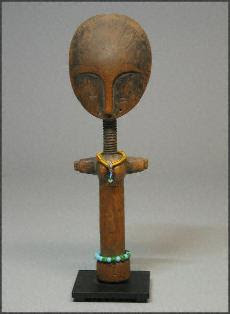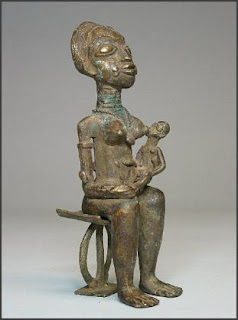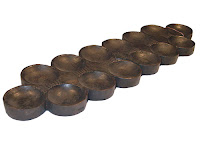Masks and Puppets of the Village Association
 |
| Bamana Puppet Farmer |
One enters the ton after circumcision and leaves it at the age of about thirty-five. Every year the ton organizes a festival of theatrical performances in the village square. These include koteba and the puppets known as sogo bo in a succession of light-hearted sketches that satirize aspects of Bamana social and religious life.
Prior to the public performances, ton members parade through the village streets accompanying masks (sogow) such as Ngon and Ntomo. Sogobaw (big beasts) resemble small mobile theaters with a head and a wood-frame body. Small puppets, expertly manipulated, emerge from the back of this "beast".
Traditions of the Bozo, Somono, Marka and Bambara
Twice a year, the Bozo, Somono, Marka and Bambara populations of Central West Mali perpetuate a long tradition of sogo (animal) mask dances, sometimes accompanied by jiri maanin (little wooden people). The purpose of these festivals, called Sogo bo (animal outings) or Tyeko (the thing of men) or Do bo (the manifestation of the mystery), is to enact original myths, legends, the cosmos and ancestors, as well as all the new things in the world.
They also depict the psychology of the human character. The youth in the villages are responsible for performing the masquerades based on the information they learn from the elders.
 |
| Bamana Farmer and Goat Marionette |
The interpretation of the theater's bush animal characters are informed by beliefs and values associated with hunting and with hunters as men of action and society's heroes. It is the world of the hunter and the association of hunting with heroic behavior that young men in the youth association, the owners of the masquerades, choose to identify with, and to celebrate through the performance of these bush animal masquerades.
The repertoire that a troupe plays in any year underscores a fundamental principle of youth theater which gives a positive value to innovation and change. The dramatic content of the youth theater is concerned with exploring the interplay between unity and rivalry, between the elders and youth, between the collective and the individual, and between tradition and change.
Each season a troupe will choose to play many of the same characters popularized by their fathers and grandfathers before them. But each new generation of young men is also charged to create new characters to rival those of their elders. While the community invests a high value in unity through the maintenance of tradition, it also recognizes that creative rivalry energizes these performances, in the same way that people understand the necessity for innovation and change in order to move the society forward.
 |
| When you pull the strings, the child raises up and down in the mother's arms. |
For generations, this theater has constituted one important public avenue through which young men and women have gained access to knowledge, instruction, and experience by commenting upon the critical beliefs and values within their communities.
References: The Sogow by Mary Jo Arnoldi in Bamana: The Art of Existence in Mali. New York: Museum of African Art - Mary Jo Arnoldi - Playing With Time - Art and Performance in Central Mali and Rand African Art







.jpg)

+wood.jpg)




.jpg)


